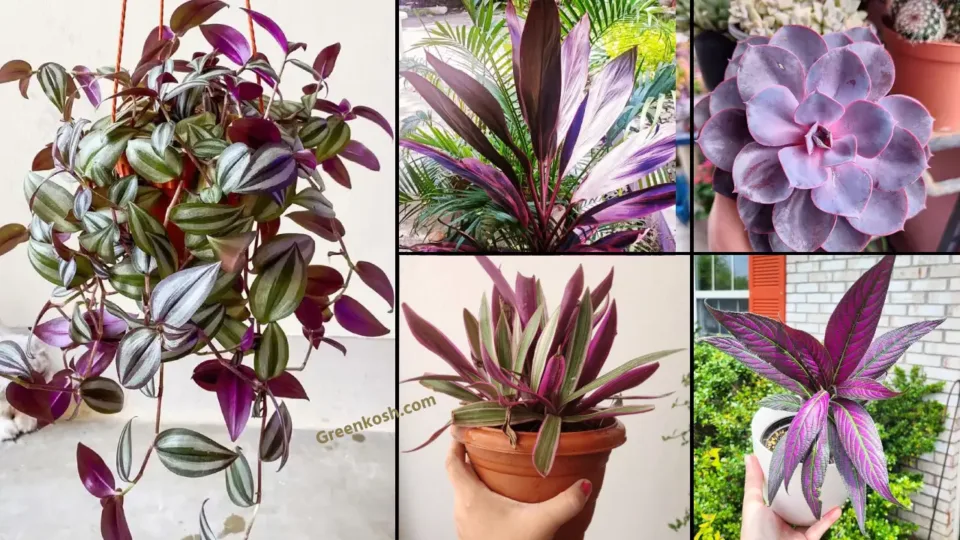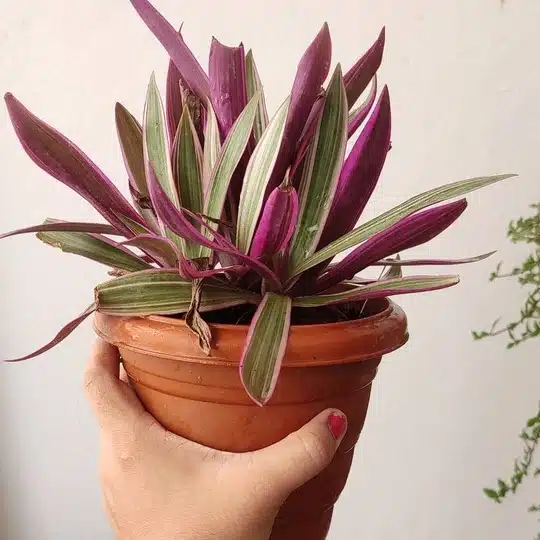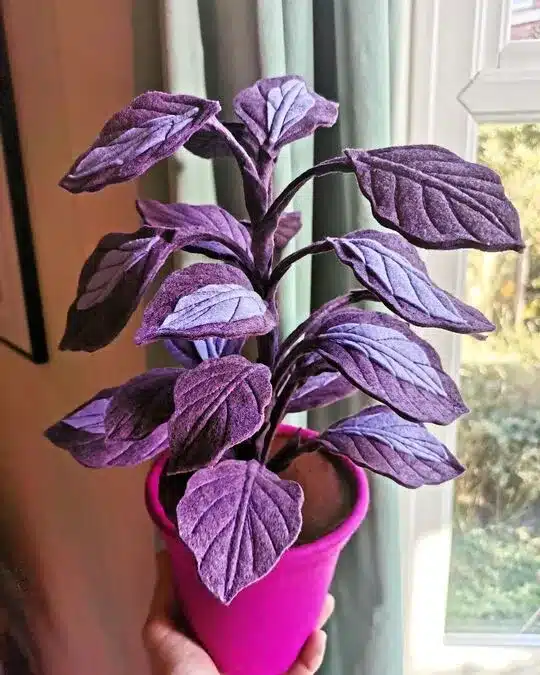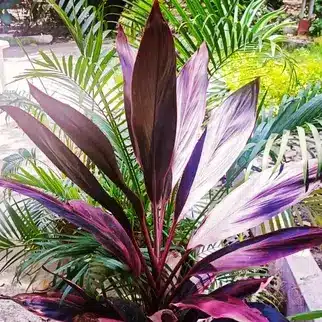When it comes to indoor plants, green is the color that often comes to mind. However, if you’re looking to add a touch of elegance and drama to your indoor space, why not consider houseplants with purple leaves?

These captivating plants not only bring a unique aesthetic to your home but also offer a range of benefits, from air purification to stress reduction. In this article, we will explore eight stunning house plants with purple leaves that are sure to make a bold statement in any room.
1. Oxalis Triangularis

The Oxalis Triangularis, commonly known as the Purple shamrock plant or Purple Oxalis, is a mesmerizing plant that features delicate, triangular-shaped leaves in a rich shade of purple.
Its leaves fold up at night and open up again during the day, adding an element of movement to your indoor garden.
This low-maintenance plant thrives in moderate light and well-draining soil, making it a perfect choice for beginners.
2. Winecraft Black Smokebush
If you’re looking for a larger house plant with purple foliage, the Winecraft Black Smokebush (Cotinus coggygria) is an excellent choice.
This shrub features deep purple leaves that mature into shades of orange and red in the fall, creating a stunning display of colors.

The Winecraft Black Smokebush thrives in full sun and well-draining soil, making it ideal for adding height and drama to your indoor garden.
3. Persian Shield

The Persian Shield, also known as the Jalpari Peacock Plant (Strobilanthes Dyeriana), is a tropical beauty with iridescent purple leaves.
Its striking foliage adds a touch of royalty and opulence to any space and plant loves direct sunlight and wet soil.
With its vibrant purple color and silver accents, the Persian Shield is sure to be a showstopper in your indoor garden.
4. Tradescantia Spathacea
The Tradescantia Spathacea, commonly known as Moses-in-the-Cradle, is a unique plant with deep purple leaves and small white flowers nestled in boat-shaped bracts.
This plant is known for its resilience and ability to thrive in various light conditions, making it a versatile addition to any indoor space.

Its low-maintenance nature and striking color make it a popular choice for plant enthusiasts.
5. Ocimum Basilicum ‘Dark Opal’

If you’re a fan of culinary herbs and want to add a splash of purple to your indoor garden, consider the Ocimum basilicum ‘Dark Opal.’
This variety of basil features deep purple leaves with a sweet, spicy flavor. Not only does it add visual interest to your kitchen, but it also provides a fresh supply of aromatic leaves for your culinary adventures.
‘Dark Opal’ basil requires bright light and well-draining soil to thrive.
6. Echeveria ‘Purple Pearl’
Echeverias are popular succulent plants known for their rosette-shaped leaves. The Echeveria ‘Purple Pearl’ is no exception, showcasing beautiful shades of purple and green in its foliage.
This compact succulent is drought-tolerant and requires bright light to maintain its vibrant colors. With its eye-catching look and ease of care, the ‘Purple Pearl’ is a must-have for every succulent enthusiast.

7. Cordyline Fruticosa (Ti Plant)

The Cordyline fruticosa, commonly known as the Ti Plant, is a tropical beauty with long, arching leaves in shades of purple and burgundy.
This plant brings a touch of exotic elegance to any indoor space and can be grown as a striking focal point or in groups for added impact.
Because the Ti Plant likes bright, indirect light and wet soil, it is ideal for well-lit parts of your house.
8. Tradescantia Zebrina
The Wandering Jew Plant, Tradescantia Zebrina, is a trailing vine with beautiful purple and silver-striped leaves.
This plant is known for its easy propagation and fast growth, making it an excellent choice for hanging baskets or as a cascading plant on shelves.

It enjoys strong, indirect light and prefers slightly moist soil. With proper care, this plant can quickly become a focal point in any room.
In conclusion, house plants with purple leaves are a fantastic way to add a sense of drama, elegance, and vibrancy to your indoor space. There are numerous selections to suit every preference and level of expertise, ranging from delicate leaves to striking tropical plants. Whether you’re a seasoned plant enthusiast or a beginner looking to dip your toes into the world of indoor gardening, these eight stunning plants will undoubtedly make a statement in your home. So, go ahead and introduce these captivating purple-leafed plants to your indoor garden and enjoy the beauty they bring to your living space.
FAQs
Q1: Are house plants with purple leaves difficult to care for?
Not necessarily. While each plant has its specific care requirements, many house plants with purple leaves, such as the Oxalis Triangularis or Tradescantia Zebrina, are generally low-maintenance and suitable for beginners. Just ensure they have the right amount of light, water, and well-draining soil.
Q2: Can I place house plants with purple leaves in any room?
Yes, you can place these plants in any room as long as they receive the appropriate lighting conditions. Some plants, like the Wandering Jew or Persian Shield, thrive in bright, indirect light, while others, like the Moses-in-the-Cradle, are more adaptable to different light levels.
Q3: Do house plants with purple leaves have any benefits besides their aesthetic appeal?
Absolutely! Like other house plants, those with purple leaves offer a range of benefits. They contribute to indoor air purification by removing toxins and releasing oxygen. Additionally, having plants indoors has been linked to reduced stress levels and improved mood, making them excellent additions to any space.
Q4: Can I propagate house plants with purple leaves?
Yes, many of these plants, such as the Wandering Jew and Persian Shield, are known for their ease of propagation. You can propagate them by taking stem cuttings and placing them in water or soil, allowing them to develop roots and grow into new plants.
Q5: Are there any specific care tips for house plants with purple leaves?
While care requirements vary, here are a few general tips: provide adequate light, but avoid direct sunlight that may cause leaf burn; water them when the top inch of soil is dry, ensuring proper drainage; and fertilize occasionally with a balanced houseplant fertilizer to support healthy growth and vibrant foliage. Always check the specific care guidelines for each plant to ensure optimal conditions.
